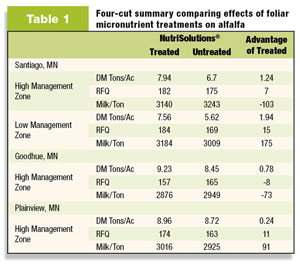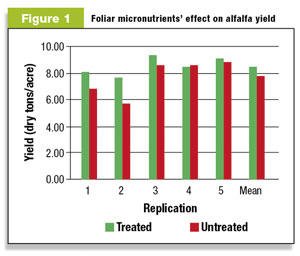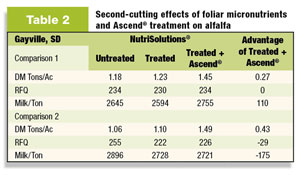Plant tissue testing for alfalfa is available to help you recognize deficient nutrients. The producer can then apply the recommended foliar applications to provide the alfalfa stand the necessary nutrients to maximize genetic potential.
Each ton of harvested alfalfa removes the fertilizer equivalent of approximately 50 pounds of potassium, 12 pounds of phosphorus, 5 pounds each of magnesium and sulfur, as well as several important micronutrients.
Those nutrients need to be replaced throughout the growing season in order to yield high-quality forage, says Winfield Solutions micronutrient product manager Tim Eyrich.
Boron and other nutrients are vital to alfalfa’s growth – deficiencies of these nutrients and others can be detected and potentially corrected during the growing season.
Plant tissue testing is a unique opportunity for alfalfa producers. Since alfalfa will be harvested multiple times each year, each cutting is another chance to sample and correct potential nutrient deficiencies.
It’s all about alfalfa leaves and stems. More healthy leaves mean higher forage quality, and more digestible stems mean higher yield.
As crop values have increased, so has the need to get the most from each acre and ton of feed we produce.
The plant tissue test is to be used as a supplement to basic soil test pH, P and K information.
Tissue sampling each alfalfa cutting provides an ideal “snapshot” to verify potential nutrient deficiencies and correct them during the same growing season.
This season, we decided to test multiple locations across the upper Midwest to help determine the potential benefits of tissue sampling and applying the recommended foliar micronutrients.
 Some preliminary results have been compiled and can be found in Table 1.
Some preliminary results have been compiled and can be found in Table 1.
The benefits of applying these recommended micronutrients to growing alfalfa are most apparent in yield advantage.
We saw the greatest yield response in areas that have previously been managed at minimum levels.
As you can see in Table 1, in the low-management zone, the NutriSolutions® treated test had nearly a 2-ton advantage over the untreated test.
In Minnesota, average yield response across all test locations was 0.82 DM tons per acre (Figure 1). Visual observations show that the treated test plot contained more mature plants and seemed to be growing more rapidly than the untreated check. This observation may help explain the yield advantage.
 On average, the relative forage quality (RFQ) shows that there was an advantage in the treated test. The concluding idea is that if harvest schedules for the treated alfalfa were adjusted between three to five days sooner (in order to capture similar plant maturity as the untreated alfalfa), the RFQ values for the treated test would have been more significant.
On average, the relative forage quality (RFQ) shows that there was an advantage in the treated test. The concluding idea is that if harvest schedules for the treated alfalfa were adjusted between three to five days sooner (in order to capture similar plant maturity as the untreated alfalfa), the RFQ values for the treated test would have been more significant.
A separate test plot was designed to test the potential benefits of the recommended micronutrient application over the untreated check, with the addition of another component.
The third treatment included an application of growth regulator in addition to the recommended micronutrient treatment.
 The results can be found in Table 2. This test treatment was only measured at the second cutting, but you can see that the yield advantage of the micronutrient treatment plus Ascend® plant growth regulator had a significant response to yield.
The results can be found in Table 2. This test treatment was only measured at the second cutting, but you can see that the yield advantage of the micronutrient treatment plus Ascend® plant growth regulator had a significant response to yield.
To value these yield responses in dollars per acre, here is a quick example. Estimated price of hay is $150 per ton. $150 * 1.18 (untreated check DM tons per acre) = $177 per acre; $150 * 1.45 (treated + Ascend® DM tons per acre) = $217.50, a difference of $40.50.
The treatment plus Ascend® cost is $28 per acre, leaving you with $12.50 per acre net income benefit over the untreated check per cutting.
The “prescription” application of micronutrients using the NutriSolutions® tool may be a great way to fine-tune your alfalfa production.
Adding some extra yield and forage quality can add up on the bottom line. Critical plant nutrients, growth promoters and other crop protection treatments (insecticides and fungicides) can be applied to alfalfa multiple times during the growing season as needed.
Protect your crop and enhance your income potential by producing more high-quality alfalfa on each and every acre.
For more information on plant tissue and soil testing, contact your local agronomist. He or she will be able to assist in sampling and making nutrient recommendations needed for maximizing your alfalfa acres. FG











